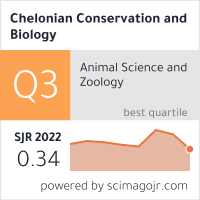TRACKING THE DISPERSAL ECOLOGY OF JUVENILE GREEN SEA TURTLES FROM THE CAYMAN ISLANDS USING SATELLITE TELEMETRY
Abstract
In movement ecology, juvenile marine animals, like sea turtles, are often understudied. We released 40 green turtle juveniles (Chelonia mydas, 1-4 years old) from two different sites off the Cayman Islands coast in January and July of 2023 with satellite tags to see how they dispersed and what impact the release had. The determinants of turtles' directional swimming persistence, including the effect of ocean current direction, were determined using a statistical model and vector plots. Within 6-22 days, almost half of the population (N = 22) successfully migrated from the islands to the surrounding regions. In contrast to the July turtles' northward spread (27-396 km), the January turtles radiated out (185-1138 km) in different directions. Daily swimming persistence rose around track ends and coastal zones, according to statistical data and vector plots. Turtles mostly swam against ocean currents. These findings show that young greens raised in captivity may find its way to important coastal environments for growth and development. Dispersal differences between January and July provide further evidence that release site and timing are crucial. We provide recommendations for future research on sea turtle and juvenile mobility ecology, and our findings help with conservation efforts for Caymanian green turtles that are making a comeback.
Downloads
Published
How to Cite
Issue
Section
License
Copyright (c) 2025 Chelonian Research Foundation

This work is licensed under a Creative Commons Attribution 4.0 International License.






